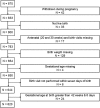Association of prenatal lipid-based nutritional supplementation with fetal growth in rural Gambia
- PMID: 27696720
- PMCID: PMC5396370
- DOI: 10.1111/mcn.12367
Association of prenatal lipid-based nutritional supplementation with fetal growth in rural Gambia
Abstract
Prenatal supplementation with protein-energy (PE) and/or multiple-micronutrients (MMNs) may improve fetal growth, but trials of lipid-based nutritional supplements (LNSs) have reported inconsistent results. We conducted a post-hoc analysis of non-primary outcomes in a trial in Gambia, with the aim to test the associations of LNS with fetal growth and explore how efficacy varies depending on nutritional status. The sample comprised 620 pregnant women in an individually randomized, partially blinded trial with four arms: (a) iron and folic acid (FeFol) tablet (usual care, referent group), (b) MMN tablet, (c) PE LNS, and (d) PE + MMN LNS. Analysis of variance examined unadjusted differences in fetal biometry z-scores at 20 and 30 weeks and neonatal anthropometry z-scores, while regression tested for modification of intervention-outcome associations by season and maternal height, body mass index, and weight gain. Despite evidence of between-arm differences in some fetal biometry, z-scores at birth were not greater in the intervention arms than the FeFol arm (e.g., birth weight z-scores: FeFol -0.71, MMN -0.63, PE -0.64, PE + MMN -0.62; group-wise p = .796). In regression analyses, intervention associations with birth weight and head circumference were modified by maternal weight gain between booking and 30 weeks gestation (e.g., PE + MMN associations with birth weight were +0.462 z-scores (95% CI [0.097, 0.826]) in the highest quartile of weight gain but -0.099 z-scores (-0.459, 0.260) in the lowest). In conclusion, we found no strong evidence that a prenatal LNS intervention was associated with better fetal growth in the whole sample.
Keywords: The Gambia; fetal growth; gestational weight gain; lipid-based nutritional supplement; randomized control trial; seasonality.
© 2016 The Authors. Maternal & Child Nutrition published by John Wiley & Sons Ltd.
Conflict of interest statement
The authors declare that they have no conflicts of interest.
References
-
- Adair, L. S. , Fall, C. H. , Osmond, C. , Stein, A. D. , Martorell, R. , Ramirez‐Zea, M. , et al. (2013). Associations of linear growth and relative weight gain during early life with adult health and human capital in countries of low and middle income: Findings from five birth cohort studies. Lancet, 382, 525–534. - PMC - PubMed
-
- Adu‐Afarwuah, S. , Lartey, A. , Brown, K. H. , Zlotkin, S. , Briend, A. , & Dewey, K. G. (2007). Randomized comparison of 3 types of micronutrient supplements for home fortification of complementary foods in Ghana: Effects on growth and motor development. American Journal of Clinical Nutrition, 86, 412–420. - PubMed
-
- Adu‐Afarwuah, S. , Lartey, A. , Okronipa, H. , Ashorn, P. , Zeilani, M. , Peerson, J. M. , et al. (2015). Lipid‐based nutrient supplement increases the birth size of infants of primiparous women in Ghana. American Journal of Clinical Nutrition, 101, 835–846. - PubMed
-
- Ashorn, P. , Alho, L. , Ashorn, U. , Cheung, Y. B. , Dewey, K. G. , Harjunmaa, U. , et al. (2015). The impact of lipid‐based nutrient supplement provision to pregnant women on newborn size in rural Malawi: A randomized controlled trial. American Journal of Clinical Nutrition, 101, 387–397. - PubMed
-
- Bhutta, Z. A. , Das, J. K. , Rizvi, A. , Gaffey, M. F. , Walker, N. , Horton, S. , et al. (2013). Evidence‐based interventions for improvement of maternal and child nutrition: What can be done and at what cost? Lancet, 382, 452–477. - PubMed
Publication types
MeSH terms
Substances
Grants and funding
LinkOut - more resources
Full Text Sources
Other Literature Sources
Medical


